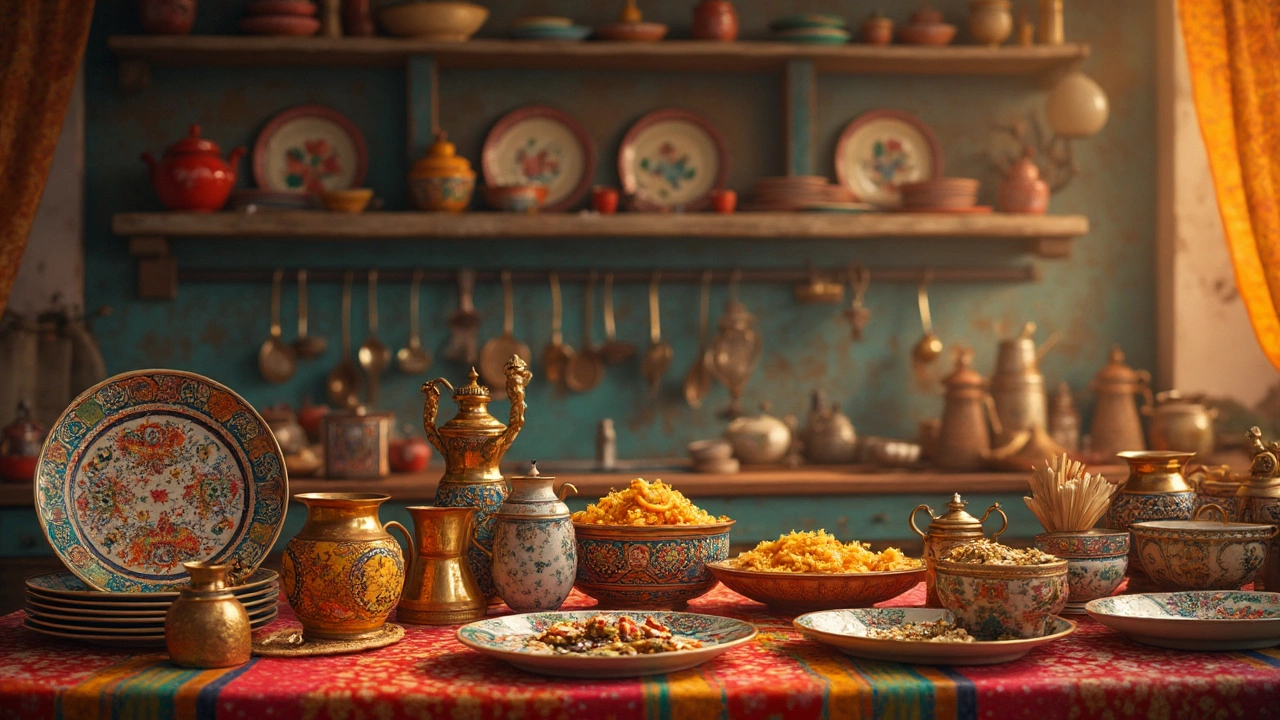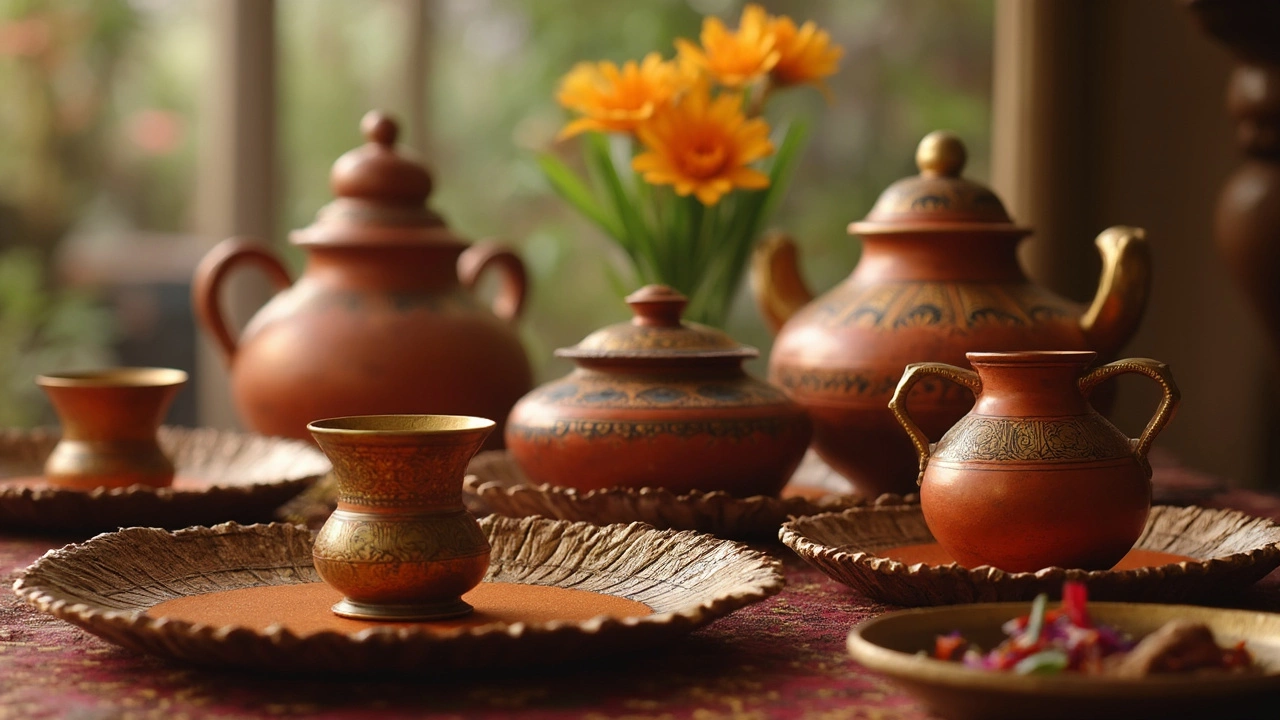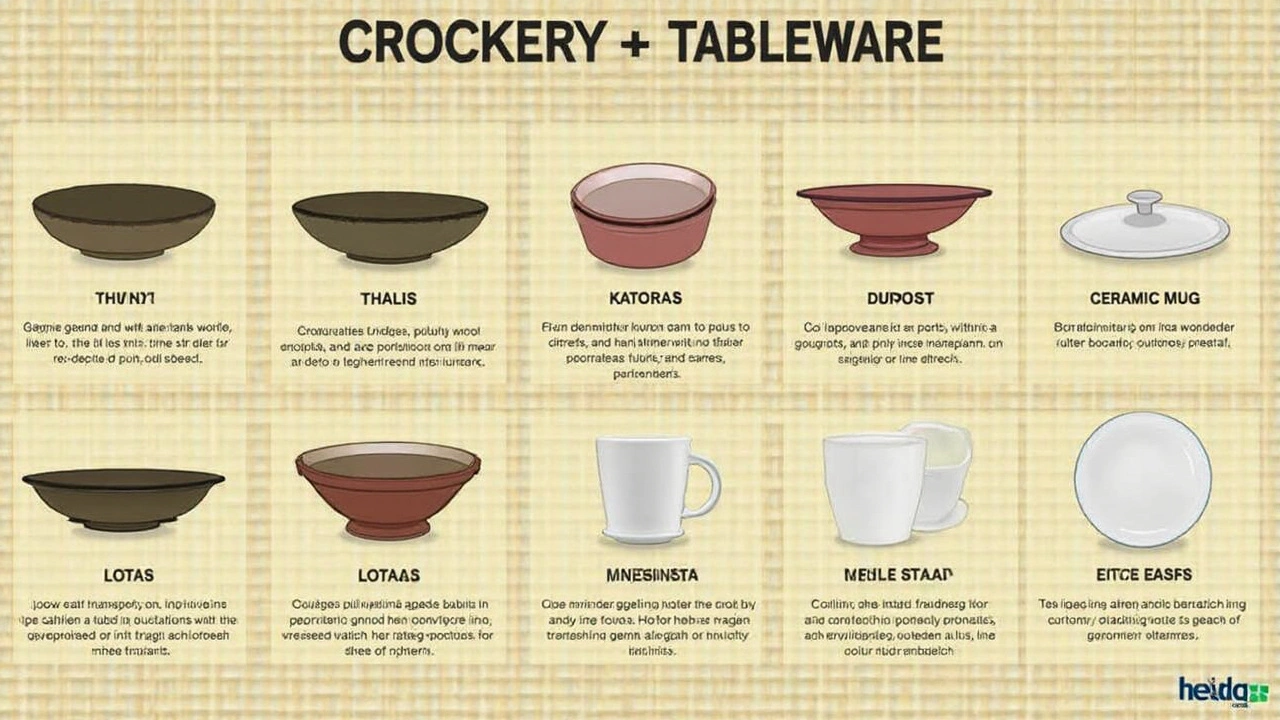Understanding the Collective Name for Cups and Plates

So, you've got a bunch of cups and plates, but what do you call them when they're together? The answer is pretty straightforward—they fall under the umbrella term 'crockery' or sometimes 'tableware'. It’s the stuff you use every day without giving a second thought, but it actually plays a bigger role in your dining experience than you might realize.
Breaking it down, crockery includes all kinds of dishes—like the plates and bowls that fill your cupboards. The word itself has a kind of dignified old-world charm, but it’s immensely practical too. When selecting your crockery, it’s not just about what looks good in your kitchen but also what fits your lifestyle.
For instance, if you've got kids, you might want something more durable, possibly unbreakable. If you're into hosting dinner parties, you could aim for something fancier. It’s all about matching the crockery to your needs and personality.
- Defining Crockery
- Components of Tableware
- Choosing the Right Set
- Care and Maintenance
- Fun Facts about Crockery
Defining Crockery
When we talk about crockery, we're diving into a world of dishes that serve not just our meals but also our dining experiences. At its core, crockery encompasses all the plates, bowls, and cups that make up your daily dining essentials. It’s a term that feels old-school yet remains a staple in the modern kitchen.
Traditionally, crockery was made from ceramics, including materials like porcelain, bone china, and earthenware. Each has its perks: porcelain is fancy but fragile, bone china is lightweight and elegant, and earthenware offers a rustic, homey feel. But these days, the choices are much broader.
Modern Choices
Materials have expanded to include stoneware, melamine, and even glass. Stoneware is perfect if you want something robust but with a touch more elegance than your standard dish. Melamine, on the other hand, is fantastic for outdoor dining because it's lightweight and hard to break.
Cultural Influence
A quick peek at history shows how crockery reflects cultural dining habits. For instance, traditional Japanese crockery often includes small, specialized dishes to complement their multi-course meals. Meanwhile, in the UK, having a separate tea service set is almost a given.
Don’t forget the impact of sustainability! More people are opting for eco-friendly options, like those made from recycled materials or bamboo. It’s not just about what's on the table but also how the choice impacts our planet.
To wrap it up, the role of crockery is more than just functional. It’s about style, sustainability, and fit for purpose. Whatever you choose, make sure it aligns with how you live and dine.
Components of Tableware
When we talk about tableware, we're diving into a world of everyday essentials that go way beyond just cups and plates. Understanding the different components can really elevate your dining game, so let's break it down.
Plates
Plates are the centerpiece of any crockery collection. You've got your dinner plates, typically around 11-12 inches in diameter, perfect for the main course. Then come salad plates, usually a bit smaller, around 8-9 inches, ideal for starters or desserts.
Bowls
Bowls serve all kinds of purposes. For soups and cereals, you have your soup bowls or cereal bowls. And don't forget those versatile pasta bowls, which are often wider and shallower, making them perfect for saucy dishes.
Cups and Mugs
Cups and mugs are where you get personal. Whether it's a dainty teacup or a hefty mug for your caffeine fix, these are crucial in any tableware setup. Some folks even like specific mugs for winter hot chocolates or iced summer teas.
Glasses
From water glasses to wine goblets, this is where you might splurge a little. Having the right glass can elevate your meal and enhance the flavor profile of your beverage. And if you're a fan of cocktails, investing in some stylish tumblers can be a great idea.
Cutlery
Last but not least, don't overlook your cutlery. A good set of knives, forks, and spoons can make a big difference at the dinner table. It's not just about functionality; matching your cutlery to your dishware can add a nice touch to your dining setup.
These are the basic components of tableware that you'd find in most homes. They're functional, but they also reflect your style and how you like to present meals. So next time you set the table, think of it as crafting a look, not just laying out some dishes.

Choosing the Right Set
When it comes to picking out the perfect kitchenware, there's more to it than just finding something pretty to put on your table. The right crockery can enhance your dining experience, make your meals more enjoyable, and even save you a bit of cleaning hassle down the line.
Consider Your Lifestyle
First things first: think about how you actually use your tableware. If you frequently have guests over, consider investing in a formal set. However, if your meals are more casual affairs, you might lean towards durable, everyday options. For families, tough materials like stoneware or melamine might be a good bet, especially when kids are in the picture.
What's Your Style?
Your personal style is key when selecting a dining essentials set. Classic white plates are timeless and versatile, blending effortlessly with any table setting or occasion. On the other hand, if you enjoy a bit of flair, you might opt for colorful or patterned sets that reflect your personality and brighten up your kitchen.
Think About Numbers
How many pieces do you really need? A standard set usually includes a dinner plate, a salad plate, a soup bowl, and a mug. But think about how often you host larger gatherings. You might want to get additional plates or bowls for those occasions. Consider buying more than one set if you frequently entertain or if your family is growing.
Material Matters
The material of your crockery can significantly affect its durability and care. Porcelain is popular for its elegant appearance and reasonable durability, while bone china is even finer and lighter, often used for formal settings. On the practical side, earthenware and stoneware are sturdy and great for everyday use.
Budget Wisely
No need to break the bank. Quality doesn’t always mean the highest price tag. Look for sales or buy items separately to gradually build up your collection without overspending. Check for brands that offer a good balance between quality and price.
Here's a quick comparison of popular materials:
| Material | Durability | Dishwasher Safe |
|---|---|---|
| Porcelain | Medium | Usually |
| Bone China | High | Yes |
| Stoneware | High | Yes |
| Earthenware | Medium | No |
In the end, choosing the right crockery isn’t just about the aesthetics. It's about finding a set that fits seamlessly into your life, offering you both functionality and style. So take your time, do some research, and enjoy the process—it’s all part of building a home you love.
Care and Maintenance
Taking good care of your crockery is key to making sure it lasts a long time. And let's face it, no one wants to sip tea from a rim with little chips, right? So here are some practical tips to keep everything in top shape.
Washing Tips
Most cups and plates are dishwasher-safe, but you should always check the manufacturer's guidelines first to be safe. For hand washing, use a soft sponge with warm soapy water. Avoid abrasive scrubbers that can scratch or dull the surface.
It's a good idea to wash them soon after use. Letting food dry and crust over can make cleaning a nightmare and causes unnecessary wear on your tableware.
Storing Your Crockery
When putting your tableware away, make sure to stack them neatly to avoid any accidental bumps. Some people like to use felt or paper liners between plates to prevent scratches, especially if they're using fancy pieces.
Dealing with Stains
If you spot any stubborn stains (like from tea or coffee), a mix of baking soda and water usually does the trick. Just apply, let it sit for a few minutes, and then scrub gently.
Repair and Replacement
We all know accidents happen. If you chip a favorite piece, repair kits are available for minor fixes, or you could keep it in the back of the cupboard for whenever you need a single serving. On the flip side, sometimes it's just better to replace them outright, especially if it impacts the function of the piece.

Fun Facts about Crockery
Did you know that crockery has been around for thousands of years? Yep, we're talking way back to ancient civilizations. The oldest pieces of pottery were discovered in China and date back to 20,000 years ago. Talk about durable dining essentials!
Fast forward to today, and you’ll find crockery made from a variety of materials like porcelain, stoneware, and bone china. But here's a neat fact: bone china is known for its strength and chip resistance. It’s made using bone ash, which might sound odd but gives it a unique touch of luxury.
Interesting Stats
In recent studies, it was found that over 85% of households in the UK own at least one set of crockery. This goes to show how ingrained these pieces are in everyday life.
Sustainability in Modern Crockery
With rising awareness around sustainability, some companies have started producing eco-friendly crockery using biodegradable materials. This means you can now enjoy your favorite dishes without worrying too much about environmental impact.
The Rise of Quirky Designs
If you thought crockery was just plain white, think again. Bold colors and funky patterns are now trending, allowing homeowners to express their personal style right on the dining table.
Whether it’s the crackle pattern in Japanese raku or the effortless elegance of Scandinavian design, crockery is a field ripe with creativity. So, next time you set your table, take a moment to appreciate the tableware and its rich history. You might just view your cups and plates a little differently.